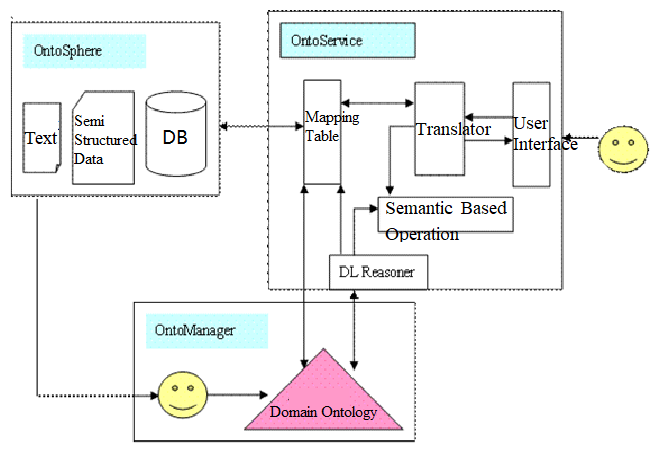According to the ontology knowledge management framework, the Intelligent Science Laboratory of the Institute of computing technology, Chinese Academy of Sciences has developed a knowledge management system kmsphere. Figure 1 shows the architecture of knowledge management system KMSphere.

Figure 1 Architecture of knowledge management system KMSphere.
1.OntoSphere
Ontology constructed by manual method generally has high quality and rich semantics. But this ontology construction method is boring, inefficient and expensive. However, the existing ontology learning methods can not obtain high-quality ontology to meet the requirements of practical applications. We combine the advantages of the two and propose a semi-automatic ontology acquisition framework. Starting from the domain application requirements, we analyze the original corpus, ontology concept learning and relationship learning, domain expert confirmation and other processes, and continue to repeat until we get the ontology that meets the requirements. In the process of concept learning, new domain concepts are found by using tools such as corpus, and new domain relationships are found by using algorithms such as hierarchical relationship learning and association rules, which improves the quality of ontology.
The framework structure of the semi-automatic ontology acquisition environment is OntoSphere, which mainly provides the following functions: document acquisition, source document preprocessing, correlation calculation, seed ontology management, vocabulary evaluation, etc. Among them, source document preprocessing and correlation calculation are the core parts. During the working process of OntoSphere, users can interact with the system.
2. OntoManager
OntoManager, a visual ontology management editing environment, provides functions such as modifying and editing existing ontologies. The manual development of ontology is a monotonous and boring thing, and it is difficult to ensure its correctness. Good tool support is essential. Tools can assist in concept recognition, consistency check and document writing, and improve the quality of ontology development. According to the different functions of tools in the process of ontology development, they can be divided into five categories: ontology development tools, ontology evaluation tools, ontology merging and mapping tools, ontology annotation tools, ontology query tools and reasoning engines.
Referring to the open source software Protégé of Stanford University, the visual editing environment is adopted, and owl code editing mode and graphical editing mode can be used.
3. OntoService
Ontoservice, a knowledge service framework, provides knowledge sharing services based on multi-agent systems, including knowledge query, active knowledge distribution services and protocol based knowledge sharing mechanisms.
The goal of OKSA, an open knowledge service system, is to establish a dynamic, cross platform, multi-agency virtual organization on large-scale and distributed web resources, and coordinate the sharing of web resources. In the three-tier architecture of OKSA: the mapping module in the ontology layer (ontology to data mapping) can solve the problem of data heterogeneity; The Dynamic Description Logic used in ontology layer can not only classify the concepts and queries in ontology, but also detect the consistency between ontology and queries; The registration / logout mechanism of ontology layer can dynamically deal with new members; The mapping module in the knowledge layer (mapping between ontologies) can solve the problem of semantic heterogeneity; Knowledge level query transformation and incremental query methods can provide users with extraordinary knowledge services in a dynamic and open environment.
Download File: